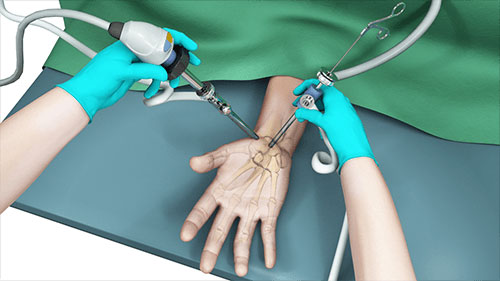Hand and Wrist Arthroscopy

Hand and wrist arthroscopy is a minimally invasive surgical procedure using a small camera (arthroscope) to diagnose and treat joint conditions. Tiny incisions allow visualization of ligaments, tendons, and cartilage, aiding in accurate diagnosis. Surgeons can then address issues such as ligament injuries or inflammation through specific arthroscopic interventions. With smaller incisions, the procedure minimizes postoperative pain and speeds up recovery compared to traditional surgery. Following surgery, rehabilitation and physical therapy may be recommended to restore normal hand and wrist function. Overall, hand and wrist arthroscopy provides an effective, less invasive approach to both diagnosis and treatment, improving patient outcomes.
Why its done
Hand and wrist arthroscopy is performed for both diagnostic and therapeutic purposes, offering a minimally invasive approach to address a variety of conditions affecting these complex structures. Here are common reasons why hand and wrist arthroscopy might be done:
Diagnostic Evaluation:
-
Unexplained Pain: When a patient experiences persistent hand or wrist pain without a clear cause, arthroscopy allows direct visualization of the joint to identify the source of discomfort.
-
Undiagnosed Conditions: In cases where imaging studies (such as X-rays or MRI scans) do not provide a conclusive diagnosis, hand and wrist arthroscopy enables a more detailed examination of the joint's interior structures.
Treatment of Joint Issues:
-
Removal of Loose Bodies: Arthroscopy can be used to remove small fragments of bone or cartilage that may be floating within the joint, causing pain or limited movement.
-
Ligament and Tendon Repairs: Tears or injuries to ligaments and tendons in the hand and wrist can be addressed through arthroscopic procedures.
-
Synovectomy: In cases of synovitis, inflammation of the synovial lining of the joint, arthroscopy may be used to remove inflamed tissue.
-
Treatment of Arthritis: While not a cure for arthritis, arthroscopy may help manage symptoms, remove loose cartilage, or address complications associated with arthritis in the hand and wrist.
Minimally Invasive Approach:
- Hand and wrist arthroscopy offers the advantage of smaller incisions compared to traditional open surgery. This results in reduced postoperative pain, faster recovery times, and minimized scarring.
Evaluation of Fractures:
- Arthroscopy can be used to assess and manage certain fractures of the hand and wrist, providing a detailed view of the extent of the injury.
Treatment of Ganglion Cysts:
- Ganglion cysts, fluid-filled lumps commonly found on the hand or wrist, can be removed or aspirated through arthroscopy.
Exploration of Joint Disorders:
- In cases of suspected joint disorders or abnormalities, arthroscopy allows for direct exploration and targeted treatment.
The decision to perform hand and wrist arthroscopy is based on a thorough evaluation of the patient's symptoms, medical history, imaging studies, and the findings during the arthroscopic procedure. The goal is to provide an accurate diagnosis and appropriate treatment to alleviate pain, improve function, and enhance the overall health of the hand and wrist joints.
Risk
Hand and wrist arthroscopy, while generally safe, carries potential risks and complications, including:
- Infection: Rare but possible, as with any surgery.
- Bleeding: Minimal risk of bleeding during or after the procedure.
- Nerve or Blood Vessel Damage: Small risk of unintended damage, leading to numbness or tingling.
- Stiffness or Weakness: Temporary postoperative effects, particularly after extensive repairs.
- Persistent Pain: Some patients may continue to experience pain, requiring further evaluation.
- Scar Tissue Formation: Excessive scar tissue may limit joint motion.
- Incomplete Healing: Tissues may not heal as expected, necessitating additional interventions.
- Anesthetic Risks: General or regional anesthesia carries inherent risks.
- Failure to Resolve Symptoms: No guarantee that all symptoms will be completely resolved.
- Complications from Specific Procedures: Nature and complexity of certain procedures may introduce additional risks.
Patients should communicate their medical history, adhere to instructions, and attend follow-up appointments for optimal care.
Procedure
Hand and wrist arthroscopy is a minimally invasive procedure involving:
Anesthesia: General or regional anesthesia is administered.
Incision Placement: Small incisions (less than half an inch) are made around the affected joint.
Arthroscopic Inspection: An arthroscope with a camera is inserted to visualize the joint on a monitor.
Diagnostic Evaluation: Cartilage, ligaments, and tendons are examined for conditions like arthritis or injuries.
Treatment or Repair: Arthroscopic procedures address issues like removing loose bodies or repairing damaged structures.
Closure: Instruments are removed, and incisions are closed with stitches or adhesive strips.
Recovery and Rehabilitation: Monitored in the recovery room, followed by postoperative physical therapy.
Postoperative Care: Patients receive instructions for wound care, pain management, and movement guidelines.
Hand and wrist arthroscopy offers precision, minimal tissue disruption, and faster recovery compared to traditional surgery. Specific procedures depend on the individual's diagnosis.
